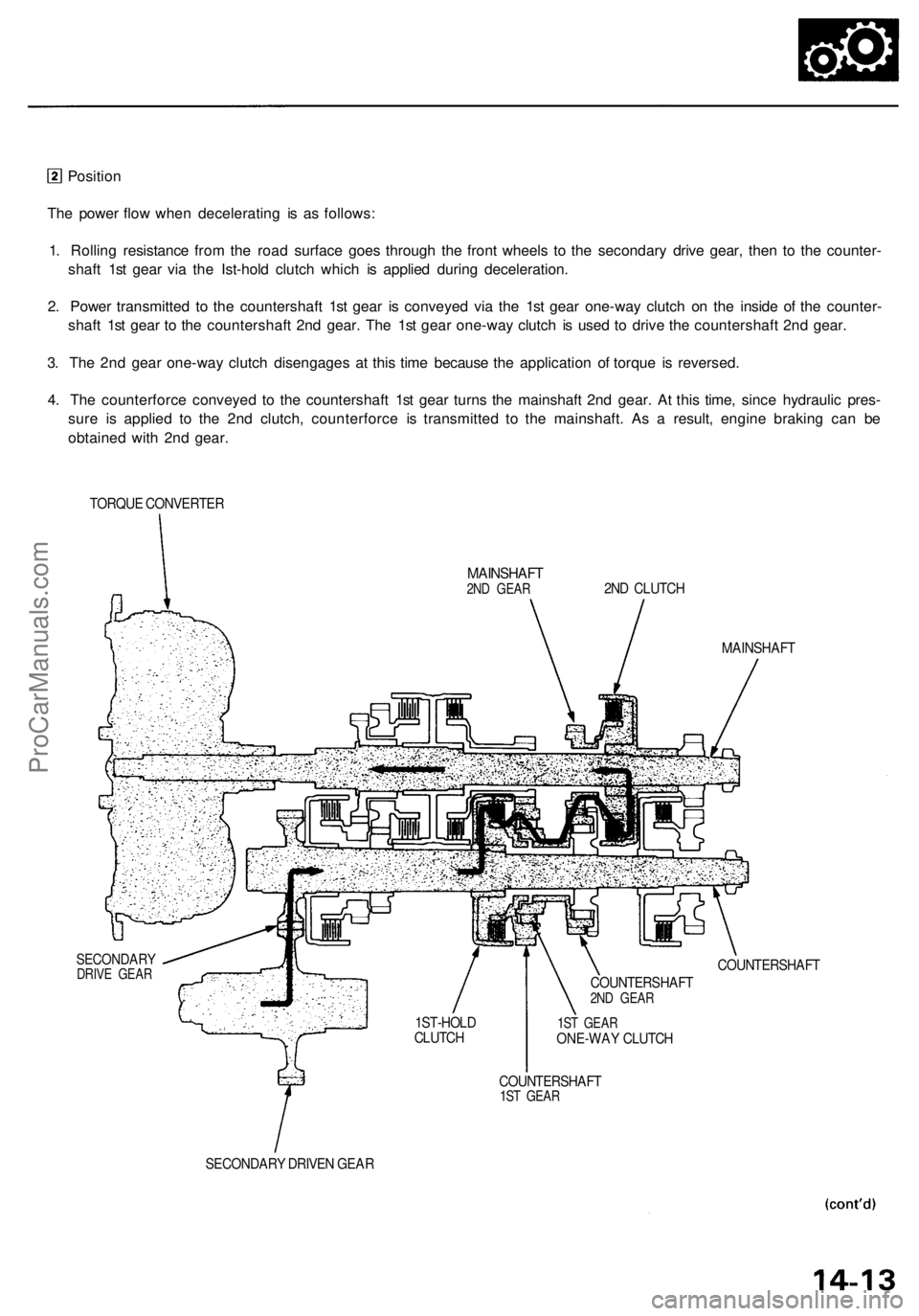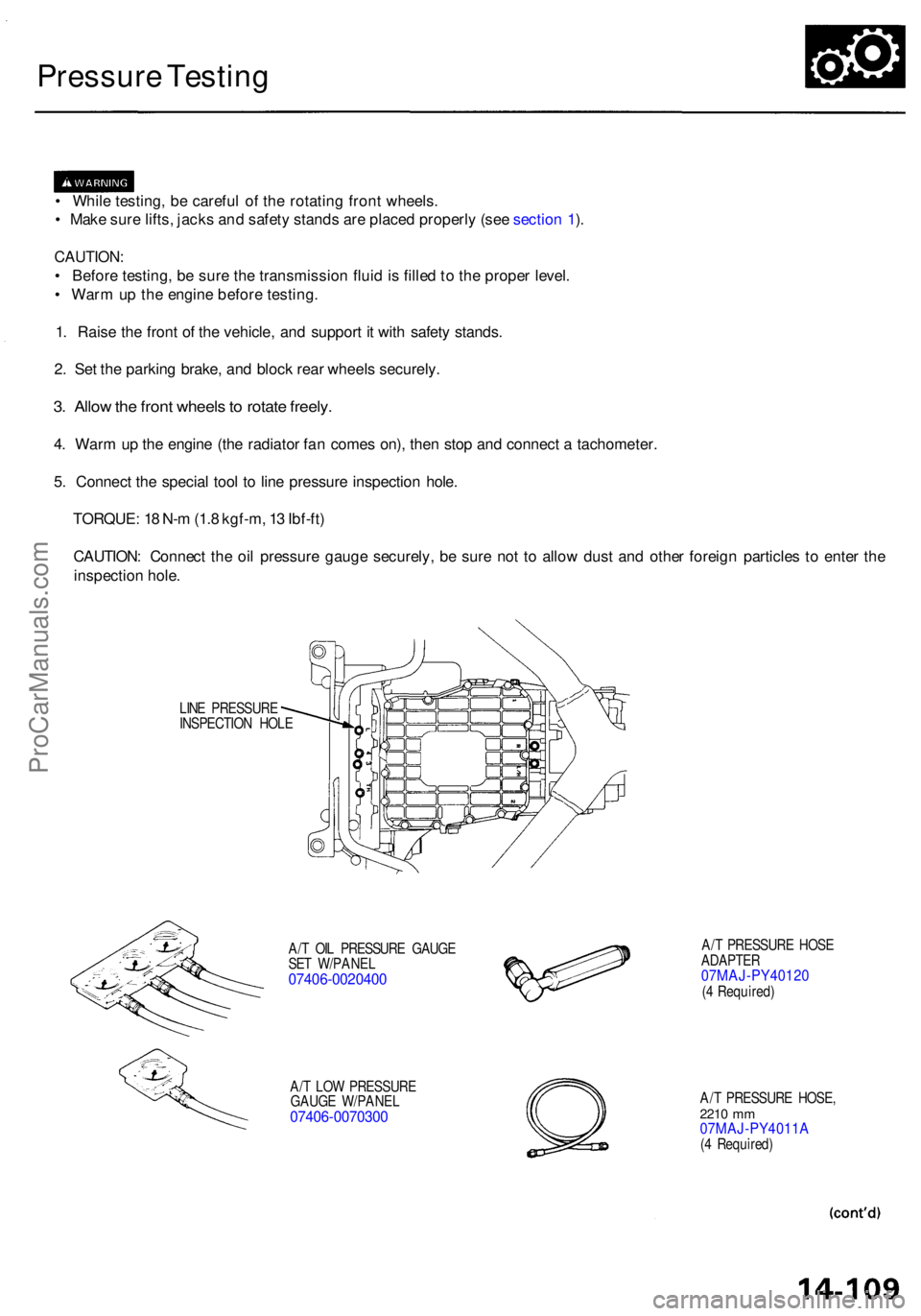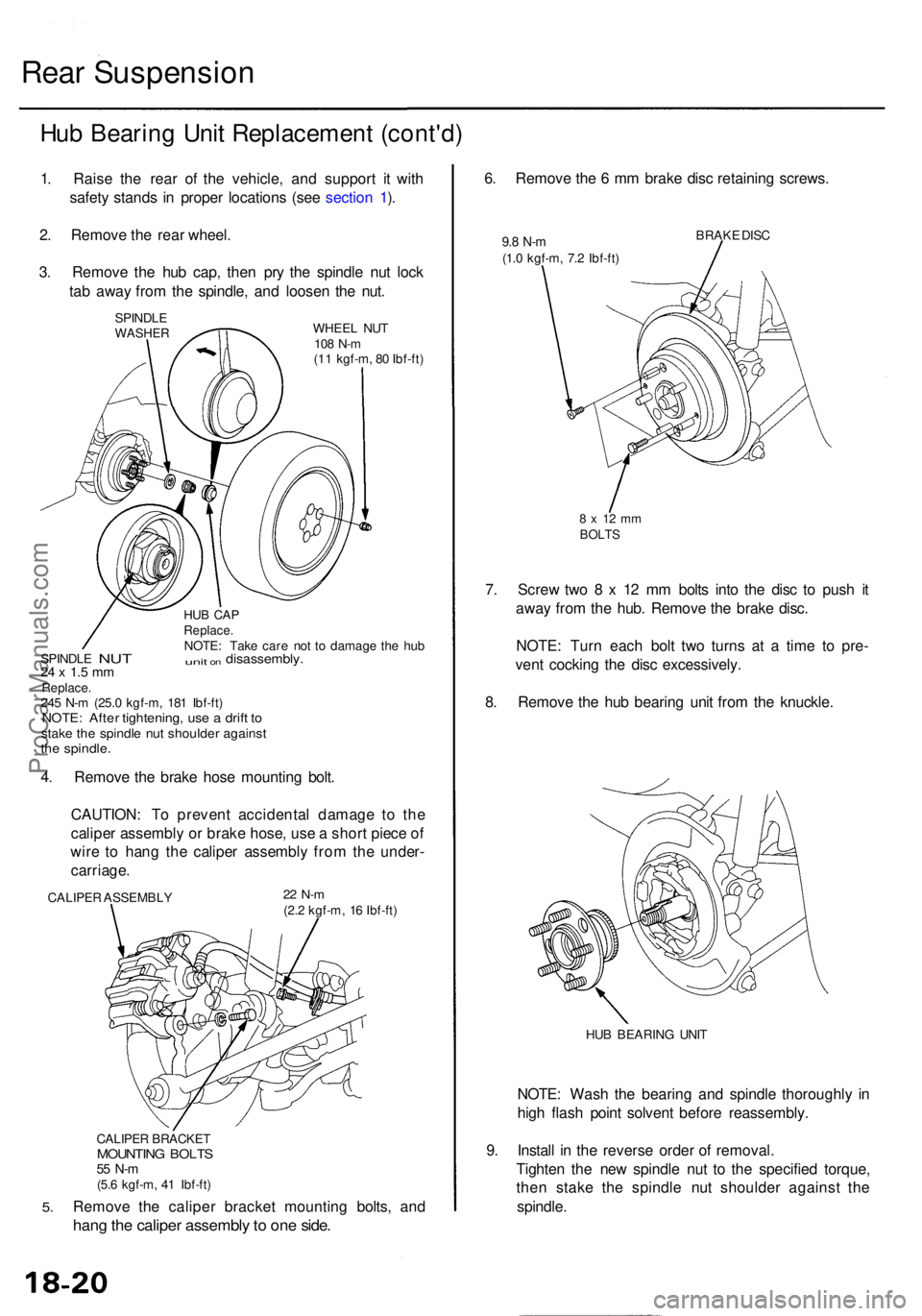1996 ACURA RL KA9 wheel torque
[x] Cancel search: wheel torquePage 712 of 1954

Description
The automatic transmission is a combination of a 3-element torque converter and a dual-shaft electronically controlled
automatic transmission which provides 4 speeds forward and 1 reverse. The entire unit is positioned in line with the engine.
Torque Converter, Gears and Clutches
The torque converter consists of a pump, turbine and stator, assembled in a single unit. They are connected to the engine
crankshaft so they turn together as a unit as the engine turns. Around the outside of the drive plate is a ring gear which
meshes with the starter pinion when the engine is being started.
The entire torque converter assembly serves as a flywheel while transmitting power to the transmission mainshaft.
The transmission has two parallel shafts: the mainshaft and the countershaft. The mainshaft is in line with the engine
crankshaft. The mainshaft includes the 1st, 4th and 2nd clutches and gears for 4th, 1st, 2nd and reverse (3rd gear is integral
with the mainshaft). The countershaft includes the 3rd, 1st-hold and reverse clutches, and gears for 3rd, 4th, 1st, 2nd,
reverse and park. The secondary drive gear is integrated with the countershaft. The gears on the mainshaft are in constant
mesh with those on the countershaft. When certain combinations of gears in the transmission are engaged by clutches,
power is transmitted from the mainshaft to the countershaft to provide , , , and positions.
Electronic Control
The electronic control system consists of a Powertrain Control Module (PCM), sensors, a A/T clutch pressure control solenoid
and four solenoid valves. Shifting and lock-up are electronically controlled for comfortable driving under all conditions.
The PCM is located below the dashboard, under the front lower panel on the passenger's side.
Hydraulic Control
The lower valve body assembly includes the main valve body, the secondary valve body, the throttle valve body, the
solenoid, the shift solenoid valves and the ATF passage body. They are bolted on the lower part of the transmission hous-
ing. Other valve bodies, the regulator valve body, the ATF pump body and the accumulator body, are bolted to the torque
converter housing.
The main valve body contains the manual valve, the 1-2 shift valve, the 2-3 shift valve, the 3-4 shift valve, the 4-3 kick-down
valve and the main orifice control valve. The secondary valve body contains the 3-4 orifice control valve, the 4-3 shift timing
valve, the line pressure control valve, the modulator valve and the accumulator pistons. The throttle valve body includes
the throttle valve which is bolted onto the secondary valve body. The A/T clutch pressure control solenoid is joined to the
throttle valve body. The regulator valve body contains the regulator valve, the lock-up shift valve and the cooler relief valve.
Fluid from the regulator passes through the manual valve to the various control valves. The ATF pump body contains the
lock-up timing valve, the lock-up control valve and the relief valve. The torque converter check valve is located in the torque
converter housing under the ATF pump body. The accumulator body contains the accumulator pistons. The reverse accu-
mulator and the 1st-hold accumulator pistons are assembled in the rear cover.
The 1st, 1st-hold, 2nd and reverse clutches receive fluid from their respective feed pipes, and the 3rd and 4th clutches
receive fluid from the internal hydraulic circuit.
Shift Control Mechanism
Input from various sensors located throughout the vehicle determines which shift solenoid valve the PCM will activate.
Activating a shift solenoid valve changes modulator pressure, causing a shift valve to move. This pressurizes a line to one
of the clutches, engaging the clutch and its corresponding gear.
Lock-up Mechanism
In position, in 2nd, 3rd, and 4th, and position in 3rd, pressurized fluid is drained from the back of the torque con-
verter through a fluid passage, causing the lock-up piston to be held against the torque converter cover. As this takes
place, the mainshaft rotates at the same speed as the engine crankshaft. Together with hydraulic control, the PCM opti-
mizes the timing of the lock-up mechanism. The lock-up valves control the range of lock-up according to torque converter
clutch (lock-up control) solenoid valves A and B, and throttle valve. When torque converter clutch (lock-up control)
solenoid valves A and B activate, modulator pressure changes. The torque converter clutch (lock-up control) solenoid
valves A and B are mounted on the torque converter housing, and are controlled by the PCM.ProCarManuals.com
Page 720 of 1954

Position
The power flow when decelerating is as follows:
1. Rolling resistance from the road surface goes through the front wheels to the secondary drive gear, then to the counter-
shaft 1st gear via the 1st-hold clutch which is applied during deceleration.
2. The 1st gear one-way clutch disengages at this time because the application of torque is reversed.
3. The counterforce conveyed to the countershaft 1st gear turns the mainshaft 1st gear. At this time, since hydraulic pres-
sure is also applied to the 1st clutch, counterforce is also transmitted to the mainshaft. As a result, engine braking can
be obtained with 1st gear.
TORQUE CONVERTER
1ST CLUTCH MAINSHAFT 1ST GEAR
MAINSHAFT
SECONDARY
DRIVE GEAR
COUNTERSHAFT
COUNTERSHAFT
1ST GEAR
SECONDARY DRIVEN GEAR
1ST-HOLD
CLUTCHProCarManuals.com
Page 722 of 1954

Position
The power flow when decelerating is as follows:
1. Rolling resistance from the road surface goes through the front wheels to the secondary drive gear, then to the counter-
shaft 1st gear via the Ist-hold clutch which is applied during deceleration.
2. Power transmitted to the countershaft 1st gear is conveyed via the 1st gear one-way clutch on the inside of the counter-
shaft 1st gear to the countershaft 2nd gear. The 1st gear one-way clutch is used to drive the countershaft 2nd gear.
3. The 2nd gear one-way clutch disengages at this time because the application of torque is reversed.
4. The counterforce conveyed to the countershaft 1st gear turns the mainshaft 2nd gear. At this time, since hydraulic pres-
sure is applied to the 2nd clutch, counterforce is transmitted to the mainshaft. As a result, engine braking can be
obtained with 2nd gear.
TORQUE CONVERTER
MAINSHAFT
2ND GEAR
2ND CLUTCH
MAINSHAFT
SECONDARY
DRIVE GEAR
COUNTERSHAFT
1ST GEAR
ONE-WAY CLUTCH
COUNTERSHAFT
1ST GEAR
SECONDARY DRIVEN GEAR
1ST-HOLD
CLUTCH
COUNTERSHAFT
2ND GEARProCarManuals.com
Page 816 of 1954

Pressure Testin g
• Whil e testing , b e carefu l o f th e rotatin g fron t wheels .
• Mak e sur e lifts , jack s an d safet y stand s ar e place d properl y (se e sectio n 1 ).
CAUTION :
• Befor e testing , b e sur e th e transmissio n flui d is fille d to th e prope r level .
• War m up th e engin e befor e testing .
1 . Rais e th e fron t o f th e vehicle , an d suppor t i t wit h safet y stands .
2 . Se t th e parkin g brake , an d bloc k rea r wheel s securely .
3. Allo w th e fron t wheel s to rotat e freely .
4. War m u p th e engin e (th e radiator fan come s on) , the n sto p an d connec t a tachometer .
5 . Connec t th e specia l too l t o lin e pressur e inspectio n hole .
TORQUE : 1 8 N- m (1. 8 kgf-m , 1 3 Ibf-ft )
CAUTION : Connec t th e oi l pressur e gaug e securely , b e sur e no t t o allo w dus t an d othe r foreig n particle s t o ente r th e
inspectio n hole .
LINE PRESSUR E
INSPECTIO N HOL E
A/ T OI L PRESSUR E GAUG E
SE T W/PANE L
07406-002040 0
A/T LO W PRESSUR E
GAUG E W/PANE L
07406-007030 0
A/T PRESSUR E HOS E
ADAPTE R
07MAJ-PY4012 0(4 Required )
A/ T PRESSUR E HOSE ,
2210 mm07MAJ-PY4011 A(4 Required )
ProCarManuals.com
Page 1022 of 1954

12. Instal l th e fron t wheels .
13 . Fil l th e syste m wit h th e recommende d powe r steer -
in g fluid , an d blee d ai r fro m th e syste m (se e pag e
17-16 ).
14 . Afte r installation , perfor m th e followin g checks .
• Star t th e engine , allo w it t o idle , an d tur n th e steer -
in g whee l fro m lock-to-loc k severa l time s t o war m
u p th e fluid . Chec k th e gearbo x fo r leak s (se e pag e
17-23 ).
• Adjus t th e fron t to e (se e sectio n 18 ).
• Chec k th e steerin g whee l spok e angle . Adjus t b y
turnin g th e righ t an d lef t tie-rods , i f necessary .
NOTE : Tur n th e righ t an d lef t tie-rod s equally .
11
. Reconnec t th e tie-ro d end s t o th e steerin g knuckles ,
tighte n th e castl e nu t ('9 6 - 9 8 models ) o r he x nu t
('9 9 - 0 1 models ) t o th e specifie d torque , an d instal l
ne w cotte r pins .
NOTE : Befor e connectin g th e tie-ro d ends , wip e of f
an y greas e contaminatio n fro m th e bal l join t tapere d
sectio n an d threads .
CAUTION : Torqu e th e castl e nu t t o th e lowe r torqu e
specification , the n tighte n it onl y fa r enoug h to alig n
th e slo t wit h th e pi n hole . D o no t alig n th e nu t b y
loosening .
ProCarManuals.com
Page 1042 of 1954

Rear Suspensio n
Hub Bearin g Uni t Replacemen t (cont'd )
1. Rais e th e rea r o f th e vehicle , an d suppor t i t wit h
safet y stand s i n prope r location s (se e sectio n 1 ).
2 . Remov e th e rea r wheel .
3 . Remov e th e hu b cap , the n pr y th e spindl e nu t loc k
ta b awa y fro m th e spindle , an d loose n th e nut .
SPINDL EWASHE R
HUB CA PReplace .NOTE: Tak e car e no t t o damag e th e hu b
SPINDL E NUT uni t on disassembly .24 x 1. 5 m mReplace .
24 5 N- m (25. 0 kgf-m , 18 1 Ibf-ft )
NOTE : Afte r tightening , us e a drif t t ostak e th e spindl e nu t shoulde r agains tthe spindle .
4. Remov e th e brak e hos e mountin g bolt .
CAUTION : T o preven t accidenta l damag e t o th e
calipe r assembl y o r brak e hose , us e a shor t piec e o f
wir e t o han g th e calipe r assembl y fro m th e under -
carriage .
CALIPER ASSEMBL Y22 N- m(2.2 kgf-m , 1 6 Ibf-ft )
5.
CALIPE R BRACKE TMOUNTING BOLT S55 N- m(5.6 kgf-m , 4 1 Ibf-ft )
Remov e th e calipe r bracke t mountin g bolts , an d
hang th e calipe r assembl y to on e side .
6. Remov e th e 6 m m brak e dis c retainin g screws .
9.8 N- m(1.0 kgf-m , 7. 2 Ibf-ft ) BRAK
E DIS C
8 x 1 2 m mBOLT S
7. Scre w tw o 8 x 1 2 m m bolt s int o th e dis c t o pus h i t
awa y fro m th e hub . Remov e th e brak e disc .
NOTE : Tur n eac h bol t tw o turn s a t a tim e t o pre -
ven t cockin g th e dis c excessively .
8 . Remov e th e hu b bearin g uni t fro m th e knuckle .
9.
HU B BEARIN G UNI T
NOTE : Was h th e bearin g an d spindl e thoroughl y i n
hig h flas h poin t solven t befor e reassembly .
Instal l i n th e revers e orde r o f removal .
Tighte n th e ne w spindl e nu t t o th e specifie d torque ,
the n stak e th e spindl e nu t shoulde r agains t th e
spindle .
WHEEL NU T108 N- m(11 kgf-m , 8 0 Ibf-ft )
ProCarManuals.com